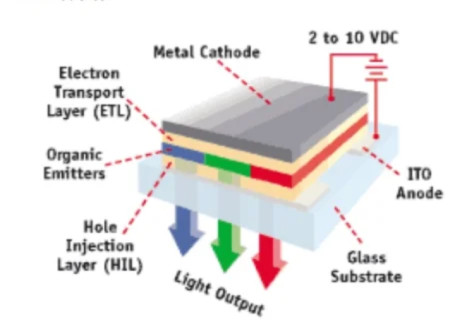OLED vs MicroLED: True Black and Efficiency Compared
02-04-2025 | By Gary Elinoff
![]()
MicroLEDs on a CMOS Substrate. Image source: Ansys
Key Takeaways about OLEDs and MicroLEDs are the keys to Brighter, More Efficient Displays
- Displays based on OLEDs and MicroLEDs, due to their ability to engender "true black" pixels, can create images of striking beauty.
- OLEDs are well-established choices for many visual applications.
- MicroLEDs are still too expensive for most use cases.
Introduction
The rapid progress in OLED Technology and the promise of MicroLEDs have shaken up the display industry in all its facets. Replacing cumbersome, old fashioned LCDs, OLEDs offer improvement in color depth, response time as well as in power savings. They are well established in many arenas, including TVs, computer monitors, headsets and smartphones.
While OLEDs are generally more expensive than LCD solutions, the costs aren't prohibitive. MicroLEDs offer even more exciting possibilities, but high costs are still slowing down adaptation.
The Nature of Digital Displays
All digital displays are based on individual points of light called pixels. A number of pixels can be used to build a visual representation of the letters or numbers. A greater number of pixels can draw a picture. ![]()
Pixels Creating an image. Image source: Stackoverflow
In the image above, the individual brown pixel points combine to form the letters A, B and C. Of course, modern displays can deploy pixels of any color visible to humans and images can be far, far more complex. But that's basically it; pixels are used to draw pictures, alphanumeric characters and more.
But what's important for today's displays are brightness, contrast, viewability at angles and a concept called "true black". Cost and durability are also key factors.
Organic light emitting diodes (OLED) and MicroLeds are both important contenders for the top spot. But before we dig into them, let's examine some basic technology.
LCDs, Color LCDs and LED Displays
LCDs (Liquid crystal displays) are illuminated by a backlight, often an LED. A voltage applied, or not applied, across the LCD's internal liquid crystal allows varying amounts of light to pass through - or not. The transmitted light will form a pixel, with many pixels formed by many LCDs building an image visible to a user.
Color LCD Displays. As described above, an LCD can only produce a black-and-white image. The right intensity of the colors red, blue and green combined can produce all colors visible to humans. So LCDs that can produce color pixels must be made up of three subpixels, one for each of those colors. The back light's light is filtered so that only red light illuminates a red subpixel, with blue and green light illuminating blue and green subpixels, respectively. The three subpixel's internal liquid crystal have the right amount of voltage applied so that the correct intensity of red, blue and green from the subpixels add up to build a resultant pixel of any color wanted.
LED Displays. Important Note! Color LCD displays, as described above, are often referred to as LED displays, but this is only partially correct. This is because the LED is only used as a backlight. But – spoiler alert - MicroLEDs and OLEDs work without LCDs and offer many advantages, as we'll soon see.
True Black
Classical "LED" displays actually employ LEDs only as backlights for LCD "front ends", as described above. Under this methodology, the LCD is programmed to shut down when the color black, (an absence of color), is the desired pixel state. However, even with the most modern LCD, the shutdown isn't 100% complete; some of the backlight's luminescence still finds its way into the pixel, and a "true black" can't be achieved.
MicroLEDs and OLEDs are light sources themselves and, thereby, need no backlight. Either can be employed to generate a single pixel. When a black pixel is called for, they turn off – completely, with no light at all coming through to gum up the works. Thus, true black is achieved, and striking images can be generated. This is of particular importance for smartphones, AR/VR headsets, and other applications where the highest quality images are mandatory.
What are OLEDs
OLEDs are light-emitting diodes whose electroluminescent elements are organic compounds.

The basic structure of an OLED. Image source: ScreenResolotionTest
The basic outline of OLED is illustrated above. Any color visible to humans can be generated by combinations of the three primary colors: red, green and blue. The amount of the red, blue and green light generated is controlled by the voltage levels provided to each organic emitter. Their light outputs combine into a single pixel, whose color is determined by the proportional mixture of the three primary colors. Geometries other than the one illustrated above are possible.
At present, OLEDs are somewhat expensive, but new production methods based on 3D printing promise cost reductions.
They are widely adapted in many consumer markets. However, tougher environments, including the automotive market, "has proven to be a challenge for OLED makers, mainly because of the inherently short lifetimes of OLED materials, and the limited operating temperatures," as per the MicroLED Association[1].
About MicroLEDs
As described by CNET[2], MicroLEDs, like OLEDs, do not use LCDs as intermediaries. Each pixel is directly created by a combination of three semiconductors, one each of the three primary colors. These are important similarities shared by MicroLEDs and OLEDs.
A 4K screen consists of 3,840 x 2,160 pixels, which comes out to about 8.3 million. Because each pixel calls for 3 MicroLEDS, that comes out to a staggering 25 million MicroLEDs. CNET notes that "Thousands of these are then grouped into modules, and multiple modules make up a TV, wall or movie screen."
A big problem here is the expense, as MicroLEDs are even more expensive than OLEDs.
OLEDs Compared to MicroLEDs
It's worth stating once again that both OLEDs and MicroLEDs can achieve beautiful, high contrast imagery because they can turn off completely to affect "true black" colors.
Unilumin[3] describes some of the advantages of each, including:
- MicroLED light output is greater, making them more suited for operation in environments with high ambient light
- OLEDs feature wider viewing angles
- MicroLEDs are more durable and have a longer lifespan
Other factors include:
- MicroLEDs can operate over a wider temperature range
- MicroLEDs are more power-efficient
- OLEDs, while not a mature technology, are far more widely adopted than MicroLEDs
AR/VR Headsets
MicroLED
When we watch our smartphone or computer screens, we can look away anytime for the reassurance of reality. But in the totally immersive augmented or virtual reality spheres, the display conveys our entire visual universe, which places enormous demand on performance. Most critical is response time – does the display respond to the narrative? Here, MicroLEDs excel with extremely fast response times.
As noted by Aledia[4] recently at CES 2025, "Tech giants have recently doubled down on microLED for smart glasses, releasing prototypes and targeting commercial launches as early as 2027." The company touts its "monolithically grown with Red, Green and Blue microLEDs on the same substrate."
The company boasts a $200 million in-house pilot production line. Confidence is high as Pierre Laboisse, president and CEO of Aledia, predicts that "by the next next CES, OLED and LCOS will already be phased out in favor of our superior microLED technology."
OLED
OLEDs are part of many current AR/VR Headsets. Manufacturers cite their excellent response times, as well as, once again, their ability to create striking images due to "true black".
Smart Phones
OLED's are a well-established choice for Smart Phones. As described by AT&T[5], "Almost all Apple iPhones use OLED technology." And, while "Apple iPhones older than the iPhone 8 (and iPhone XR, iPhone 11, and iPhone SE), have LCD screens, Starting with the iPhone X, Apple began using OLED in their higher-end iPhone models. The iPhone X, iPhone XS, iPhone XS Max, iPhone 11 Pro, and iPhone 11 Pro Max, as well as iPhones 12 through iPhone 15 all have OLED screens."
MicroLED's are certainly on the minds of manufacturers, but there is scant commercial availability as yet.
Wrapping Up
Visual displays are composed of many thousands of pixels. Each pixel is composed of combinations of the three primary colors, so each pixel needs three illuminators. This is true for MicroLEDS, OLED, or classical LCD's
Earlier LCD displays employed cumbersome fluorescent backlights, while modern ones, in various forms, use LEDs. Such displays are somewhat fallaciously referred to as LED displays.
MicroLEDs and OLEDs generate light themselves, whereas LCDs are like window shades; they allow, impede or shut off light. One of the great faults of LCDs is that they cannot completely shut off light when a black pixel is needed, which compromises the quality of the overall image generated.
OLEDs are well-established choices for many characters of displays, but MicroLEDs are not so much due to their high costs.
Challenges and Opportunities
OLEDs and MicroLEDs are direct sources of light for the pixel point. They require no LCD as a gatekeeper, and this simplicity of concept is appealing in and of itself.
Major challenges faced by OLEDs include their sensitivity to moisture and extremes in temperature. This makes them a somewhat troublesome fit for the automotive display market. This is much less an issue for indoor devices like TVs and computer screens, and they are well established choices for these use cases.
MicroLEDs are tougher and longer lasting, but their high costs are still a major impediment to more universal applications. These powerful devices are attracting the attention major industrial players, and much progress is to be expected.
References
- MicroLED Association White Paper (2024). MicroLED Association
- Is MicroLED the Future of Television? CNET
- Micro LED vs OLED: Which is Better? Unilumin
- Aledia Unveils Breakthrough microLED Technology Paving the Way for the Most Immersive Augmented Reality Experience Ever Conceived at CES 2025. BusinessWire
- What is OLED, and why does it matter? AT&T
Glossary of Terms
- Pixel. A tiny point of illumination on a display screen. Many hundreds, thousands or even millions of pixels create an overall image for a human viewer.
- True Black. This is possible with displays such as MicroLEDs or OLEDs, which, when turned off, transmit no light or color of any sort onto the pixel point. Thus, a totally black pixel results.

